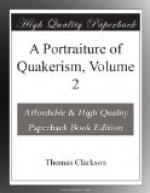And as the thing permitted was the passover, spiritualized in this manner, so it was only permitted for a time, or “until he come.”
By the words “until he come,” it is usually understood, until Christ come. But though Christians have agreed upon this, they have disagreed as to the length of time which the words may mean. Some have understood that Jesus Christ intended this spiritualized passover to continue for ever as an ordinance of his church, for that “till he come” must refer to his coming to judge the world. But it has been replied to these, that in this case no limitation had been necessary, or it would have been said at once, that it was to be a perpetual ordinance, or expressed in plainer terms, than in the words in question.
Others have understood the words to mean the end of the typical world, which happened on the destruction of Jerusalem, when the Jews were dispersed, and their church, as a national one, done away. For the coming of Christ and the end of the world have been considered as taking place at the same time. Thus the early Christians believed, that Jesus Christ, even after his death and resurrection, would come again, even in their own life time, and that the end of the world would then be. These events they coupled in their minds; “for[188] they asked him privately, saying, tell us when these things shall be, and what shall be the sign of thy coming and of the end of the world?” Jesus told them in reply, that the end of the world and his coming would be, when there were wars, and rumours of wars, and earthquakes, and famine, and pestilence, and tribulations on the earth; and that these calamities would happen even before the generation, then alive, would pass away. Now all these things actually happened in the same generation; for they happened at the destruction of Jerusalem. Jesus Christ therefore meant by the end of the world, the end of the Jewish world, or of the world of types, figures, and ordinances: and he coupled naturally his own coming with this event, because he could not come fully into the hearts of any, till these externals were done away. He alluded, in short, to the end of the Jewish dispensation and the beginning of his own spiritual kingdom, or to the end of the ceremonial and the beginning of the Gospel world.
[Footnote 188: Matt. 24.]
Those therefore who interpret the words “till he come” to mean the end of the typical world, are of opinion that the passover, as spiritualized by Jesus Christ, was allowed to the disciples, while they lived among a people, so wedded to religious ceremonies as the Jews, with whom it would have been a stumbling block in the way of their conversion, if they had seen the Apostles, who were their countrymen, rejecting it all at once; but that it was permitted, them, till the destruction of Jerusalem, after which event the Jews being annihilated as a nation, and being dispersed and mixed among the infinitely greater body of the Gentiles, the custom was to be laid aside, as the disuse of it could not be then prejudicial to the propagation of the Gospel among the community at large.




